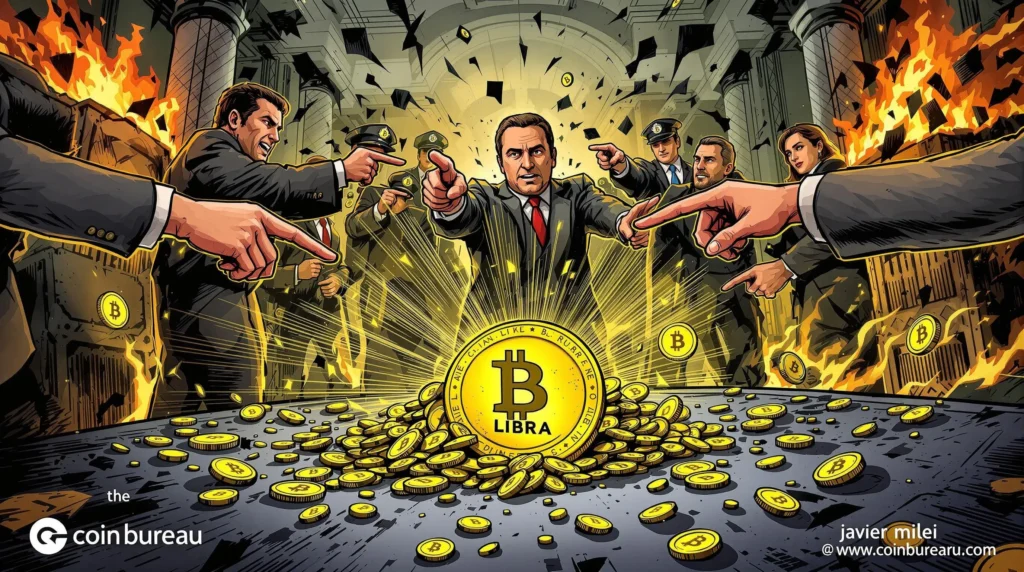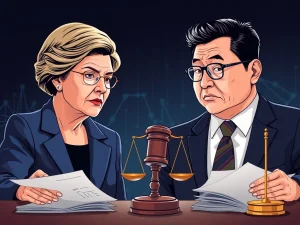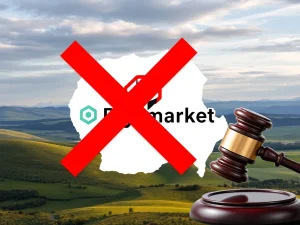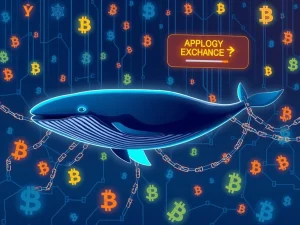Shocking LIBRA Memecoin Scandal: Are Regulators to Blame? Coin Bureau Founder Sounds Alarm

The crypto world is buzzing, and not for the usual reasons. A storm is brewing around memecoins, specifically LIBRA, which spectacularly crashed after Argentine President Javier Milei’s endorsement. But who’s really to blame for this mess? According to the founder of the popular Coin Bureau, the finger points squarely at regulators. Let’s dive into this explosive situation and understand why regulatory ambiguity might be the real culprit behind the LIBRA memecoin scandal.
The LIBRA Memecoin Scandal: A Crypto Crash Course
For those just catching up, the LIBRA memecoin incident highlights a critical issue within the crypto space: the wild west nature of memecoin markets. These digital assets, often born from internet jokes and virality, can experience meteoric rises and equally dramatic falls. LIBRA, in this case, became a prime example. Endorsed by a prominent political figure, it briefly captured attention, but soon after, it plummeted, leaving many investors in the dust. This incident has ignited a fierce debate about the role of regulators in the memecoin market. Is it their responsibility to step in and provide clarity, or is it a case of ‘buyer beware’ in the inherently risky world of crypto?
Why Coin Bureau Founder Blames Regulators for Memecoin Mayhem
The Coin Bureau founder, a respected voice in the crypto community, is not alone in questioning the regulatory landscape. The core argument revolves around the lack of clear guidelines for memecoins and similar digital assets. Here’s a breakdown of the key points:
- Absence of Legal Clarity: Unlike established cryptocurrencies like Bitcoin or Ethereum, memecoins often operate in a legal gray area. Regulators worldwide are still grappling with how to classify and regulate these assets. This ambiguity creates confusion for both developers and investors.
- Inadequate Investor Protection: Without clear regulations, there’s limited protection for investors who dive into memecoins. Scams, rug pulls, and pump-and-dump schemes can thrive in an unregulated environment. The LIBRA memecoin scandal might be a symptom of this lack of protection.
- Hindered Market Maturity: The lack of regulatory frameworks can stifle the healthy development of the crypto market. Legitimate projects might be hesitant to launch or innovate due to regulatory uncertainty, while bad actors can exploit the loopholes.
- Confusion and Misinformation: The absence of official guidance leaves room for misinformation and speculation to spread rapidly, particularly in the fast-paced world of memecoins. This can lead to irrational investment decisions and market volatility.
Memecoin Regulation: A Double-Edged Sword?
While the need for some form of crypto regulation seems increasingly apparent, especially after events like the LIBRA memecoin scandal, it’s a complex issue with potential downsides. Some argue that over-regulation could:
- Stifle Innovation: Excessive rules could crush the innovative spirit of the crypto space, making it harder for new projects, including potentially valuable memecoins, to emerge and grow.
- Centralize Control: Heavy regulation could inadvertently favor larger, established players and disadvantage smaller, decentralized projects, contradicting the ethos of cryptocurrency.
- Drive Innovation Offshore: Strict regulations in one jurisdiction might simply push crypto innovation to more lenient regions, creating a global regulatory arbitrage problem.
Therefore, the challenge for regulators is to strike a delicate balance – to provide enough clarity and protection to prevent scandals like the LIBRA memecoin collapse, without stifling innovation and pushing the industry underground. It’s a tightrope walk requiring careful consideration and a nuanced approach.
Navigating the Risky Waters of Memecoins: Investor Insights
In the meantime, while regulators worldwide deliberate on the best course of action, what can crypto investors do? Especially those tempted by the allure of high-potential memecoins? Here are some actionable insights:
- Do Your Own Research (DYOR): This is crypto investing 101, but it’s especially crucial with memecoins. Understand the project, its team (if any), its tokenomics, and its community sentiment. Don’t rely solely on hype or celebrity endorsements.
- Risk Management is Key: Memecoins are inherently volatile and risky. Only invest what you can afford to lose. Diversify your portfolio and don’t put all your eggs in one memecoin basket.
- Be Wary of Hype and FOMO: Memecoin markets are often driven by hype and fear of missing out (FOMO). Resist the urge to jump into a project solely because it’s trending. Make rational, informed decisions.
- Stay Informed About Regulation: Keep an eye on regulatory developments in your region and globally. Regulatory changes can significantly impact the crypto market, including memecoins.
Looking Ahead: The Future of Memecoins and Crypto Regulation
The LIBRA memecoin scandal serves as a stark reminder of the urgent need for clearer crypto regulation, particularly in the rapidly evolving world of memecoins. While complete consensus on the ideal regulatory framework remains elusive, the conversation is intensifying. The Coin Bureau founder’s critique highlights a crucial perspective: regulatory ambiguity is not just a bureaucratic hurdle; it can have real-world consequences, impacting investors and the overall health of the crypto ecosystem. As the crypto landscape matures, expect increased scrutiny and pressure on regulators to provide the much-needed clarity. Whether this leads to balanced and effective regulation, or stifling overreach, remains to be seen. One thing is certain: the LIBRA memecoin incident will likely be a pivotal moment in the ongoing debate about crypto regulation and investor protection.
Conclusion: Urgent Call for Crypto Regulatory Clarity
The LIBRA memecoin debacle has thrown a spotlight on a critical vulnerability in the crypto world – the lack of clear regulatory guidelines. The Coin Bureau founder’s blame on regulators resonates with many who believe that ambiguity breeds chaos and leaves investors vulnerable. While the path forward for memecoin regulation is still uncertain, the need for action is undeniable. The crypto community, regulators, and policymakers must engage in constructive dialogue to forge a regulatory framework that fosters innovation while safeguarding investors and preventing future scandals. The future of memecoins, and perhaps the broader crypto market, may well depend on it.









